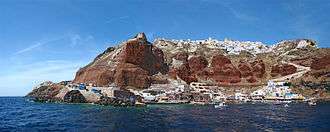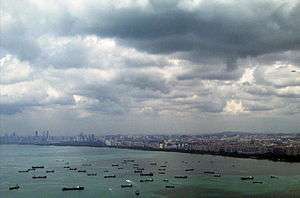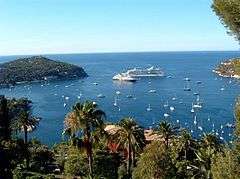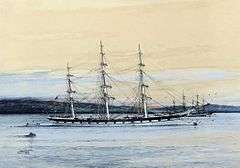Roadstead

A roadstead is a body of water sheltered from rip currents, spring tides or ocean swell outside a harbor where ships can lie reasonably safely at anchor without dragging or snatching while waiting for their turn to enter a port of call.[1][2] It can be open or natural, usually - estuary-based, or may be created artificially.[3] In maritime law, a "known general station for ships, notoriously used as such, and distinguished by the name".[4] Charts and nautical publications often use roads rather than roadsteads;[5] "Roads" is the earlier term.[6] In the days of sailing ships, some voyages could only easily be made with a change in wind direction, and ships would wait for a change of wind in a safe anchorage, such as the Downs or Yarmouth Roads. Daniel Defoe has Robinson Crusoe recall an early journey in the coastal trade: "The sixth day of our being at sea we came into Yarmouth Roads; the wind having been contrary, and the weather calm, we had made but little way since the storm. Here we were obliged to come to an anchor, and here we lay, the wind continuing contrary, viz., at southwest, for seven or eight days, during which time a great many ships from Newcastle came into the same Roads..."
Examples
- Basque Roads, France
- Brest Roads, Brittany
- Carrick Roads, England
- Castle Roads, Bermuda
- Cherbourg Harbour, (la Grande Rade) France (artificial)
- The Downs, England
- Fayal Roads, Azores, Portugal
- Gage Roads, Western Australia
- Kossol Roads, Micronesia
- Hampton Roads, Virginia, USA
- Lahaina Roads, Hawaii, USA
- The Nore, England
- Royal Roads, Canada
- Schillig Roads, Germany
- Spithead, England
- Toulon Roads, France
References
- ↑ United States Army technical manual, TM 5-360. Port Construction and Rehabilitation. Washington: United States. Government Printing Office, 1964.
- ↑ Oxford Dictionaries: Definition of roadstead in English
- ↑ Roadstead: Extensive Definition
- ↑ Black's Law Dictionary: What is roadstead?
- ↑ Walker, George K. Definitions for the Law of the Sea: Terms Not Defined by the 1982 Convention. Leiden: Martinus Nijhoff Publishers, 2012.
- ↑ Little, William; Fowler, H W; Coulson, Jesse; Onions, C T; Friedrichsen, G W S (1983). The Shorter Oxford English Dictionary on Historical Principles (Volume II) (3rd ed.). London: Book Club Associates. p. 1838.
External links
- Harbor Types of the World's Large Sized Ports, Hofstra University site
- Ports and Ocean Distances, searoutes.com
- Roadsteads around the world
 Singapore roadstead
Singapore roadstead Marseille Rade
Marseille Rade(Ludolf_Backhuysen%2C_1671).jpg) Dutch ships in the roadstead of Texel, 1671
Dutch ships in the roadstead of Texel, 1671 Roadstead of Villefranche-sur-mer
Roadstead of Villefranche-sur-mer Greek bunker vessel AGIA ZONI III at Piraeus roadstead
Greek bunker vessel AGIA ZONI III at Piraeus roadstead- Volvo Ocean Race 2012 in the roadstead of Lorient
.jpg) HNoMS Harald Hårfagre or Tordenskiold at the roadstead of Trondheim, 1906
HNoMS Harald Hårfagre or Tordenskiold at the roadstead of Trondheim, 1906 Golden Fleece lying at anchor in the roadstead (painting by Jack Spurling, 1929)
Golden Fleece lying at anchor in the roadstead (painting by Jack Spurling, 1929)
| Wikimedia Commons has media related to Roadsteads. |